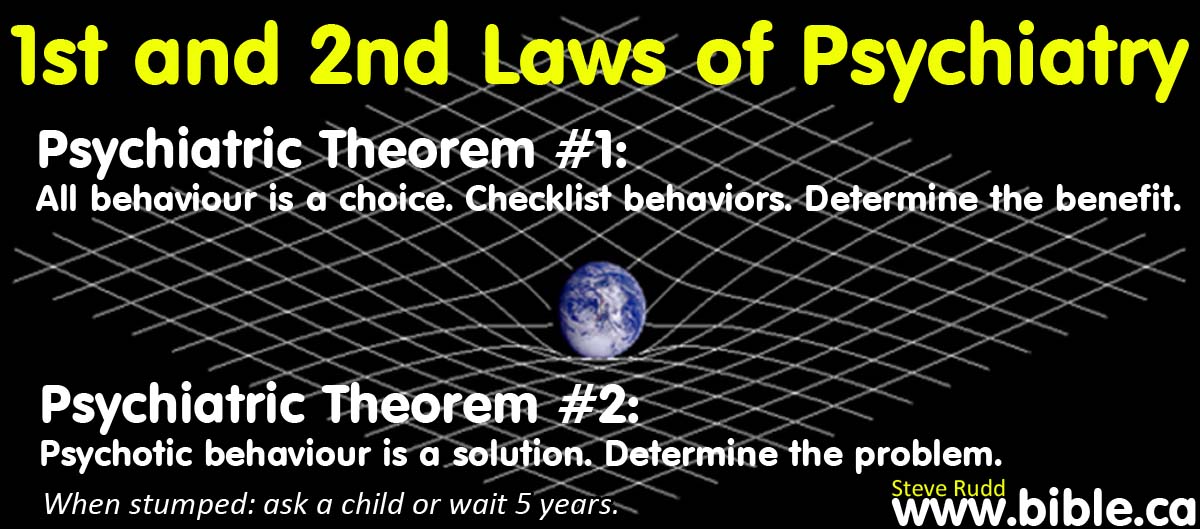The case of "Mouse" (Hysteria, Phobia: anxiety, strangulation, convulsions)
Casebook of Biblical Psychiatry © Version 7 (CBP-7)
|
Based upon |
Casebook of Biblical Psychiatry© brings the principles of Biblical Psychiatry to life based upon real-world cases and familiarizes Christians with different types of situations. This practical companion volume to Biblical Psychiatry© includes not only diagnosis, but also in-depth discussions by experienced Christians for Biblical approaches to treatment. This meticulously detailed volume of dynamic real-life case studies is simply a "must read" for all clinical Psychiatrists, mental health care professionals and Christians interested in expert opinion on today's treatment approaches. Psychiatric students, educators, and practitioners—as well as social workers, nurses, medical physicians, and interested laypersons—will find this unique volume of inestimable value in their day-to-day work.
|
|
|
|
|
The case of (Hysteria: anxiety, strangulation, convulsions) |
|
|
|
|||||
|
|
The case of "Mouse" |
||||
|
|
Biopsychiatric labels DSM-5 |
Hysteria; Phobia, conversion disorder with anxiety, strangulation, convulsions |
|||
|
|
Checklist Behaviours DSM-7 |
Deception, duty shirking, anxiety |
|||
|
|
Insights MMPI-7 |
|
|||
|
|
Quick Pick EDS-7.1 |
Complaints: I feel Unentertained, bored, dull |
|||
|
|
Self-disablement EDS-7.2 |
Employment: Time off work |
|||
|
|
Chemical imbalance EDS-7.3 |
No. Never ingested opium. Although before the era of prescribed psychiatric drugs (1950's) which create chemical imbalances in the brain, at this point in history Opium was the only drug widely used to create chemical imbalances in the brains of the insane. |
|||
|
|
Benefits EDS-7.4 |
Fun, entertainment, relief from boredom and monotony: EDS-7.4.2 Attention seeking, Pride, Praise, Honour, Fame: EDS-7.4.3 Escape duty or life situation: EDS-7.4.4 Revenge: EDS-7.4.8 |
|||
|
|
Monetary EDS-7.5 |
- |
|||
|
|
Annoyance Scale EDS-7.6 |
High |
|||
|
|
Diagnostic Laws EDS-7.7 |
Law of Narcissistic Behaviour Choice (NBC) EDS-7.7.1.NBC Law of Derivative Personal Benefit (DPB) EDS-7.7.2.DPB Law of Domino Problem Transference (DPT) EDS-7.7.4.DPT Law of Pediatric Multifarious Obfuscation (PMO) EDS-7.7.12.PMO |
|||
|
|
Determine the Problem |
Bored, overworked young girls looking for some fun |
|||
|
|
Ask a Child |
That is a fun game those kids are playing. EDS-7.7.12.PMO |
|||
|
|
5 years later EDS-7.7.LPT |
||||
|
|
|
||||
A factory is shut down when 24 young working girls are mysteriously struck with psychotic behaviour cured by shock treatment
AN EPIDEMIC OF HYSTERICS: At a Cotton Manufactory, at Hodder Bridge, in Lancashire, a girl, on the 15th of February, put a mouse into the breast of another girl who had a great dread of mice. The girl was immediately thrown into a fit, and continued in it with the most violent convulsions for 24 hours. On the following day, three more girls were seized in the same manner; and on the 17th, six more. By this time the alarm was so great, that the whole work, in which between 200 and 300 were employed, was totally stopped, and an idea prevailed that a particular disease had been introduced by a bag of cotton opened in the house.—On Sunday, the 18th, Doctor St. Clare was sent for from Preston; before he arrived, three more were seized; and during that night and the morning of the 19th, eleven more, making in all 24. Of these, 21 were young women, two were girls of about ten years of age, and one man, who had been much fatigued with holding the girls. Three of the number lived about two miles from the place where the disorder first broke out, and three at another factory at Clitheroe, about five miles distant; which last, and two more, were infected entirely from report, not having seen the other patients; but, like them and the rest of the country, strongly impressed with the idea of the plague being caught from the cotton. The symptoms were, anxiety, strangulation, and very strong convulsions; and these were so violent as to last, without any intermission, from a quarter of an hour to twenty-four hours, and to require four or five persons to prevent the patients from tearing their hair and dashing their heads against the floor or walls. Doctor St. Clare had taken with him a portable electrical machine, and by electric shocks, the patients were universally relieved without exception. As soon as the patients and country were assured that the complaint was merely nervous, easily cured, and not introduced by the cotton, no fresh person was affected. (An Epidemic Of Hysterics, William St. Clare, 1787 AD)
Discussion:
The first theorem of psychiatry is: "Behaviour is choice, checklist behaviours, determine the benefit". The benefit was obviously a combination of fun, attention seeking and getting a few days off work. Many of the girls were ten years old! When the group of girls saw that the reaction to a mouse being put down another girl's top got that girl a break from factory work, they joined in the game and got time off too! A total 24 girls began to imitate the symptoms and the cotton mill where they all worked was shut down for fear of a plague that entered the factory from a bag of cotton.
|
Clare cured them all instantly with his electric shock machine! Here is an example of how a form of torture, instantly snapped these girls out of their acting. The girl's dislike of being shocked exceeded their dislike of mice! These static electric shocks were like what you would experience by rubbing your feet on a carpet and touching the nose of a sleeping younger sibling. The shocks would be applied to the arms and body, rarely the head.
This is one of the first electric shock machines invented by John Wesley, to cure diseases of every kind, including insanity. It is the forerunner of the modern Electro-convulsive Therapy (ECT) machine. |
Historical examples of the mass induced psychosomatic behaviours:
1. In 1655 AD, Meric Casaubon had correctly speculated in his "A treatise concerning enthusiasme" (1655 AD) that such events were contagious (learned and imitated), "should be contagious: though not contagious in the same manner, as the Plague, or the Pox is; yet contagious in their kind".
2. In 1701 AD, John Freind noted a case of two related families of what became known, "the barking girls", who "barking and howling like dogs . . . accompanied by violent rhythmic movements of the head and contortions of the face . . . when their breath failed they would one by one fall into a paroxysm like an epileptic fit".
3. These three cases show that "insane behaviour" is often a game and play acting in order to achieve a benefit. But their benefit cost the adults time, money and worry.
The whole story of the girl being afraid of a mouse reminds me of when I was in grade 3 at John Wilson Public school in Oakville, Ontario, 1965 AD. I noticed that 15 minutes before recess all the girls in my class would start fidgeting and become restless but only if it was raining outside. As an adult I concluded this was because of the general aversion that women have to cold. But then, as my repressed memories kicked in, I remembered that I also started to become restless and fidgety before a rainy recess too, just like the girls. Then I remember going out to the school yard to see all the girls huddled together (something I mistook for the need for cumulative body heat) looking at me, giggling and waiting. I would then find a huge earthworm that had surfaced because of the rain. The moment I picked it up, the girls spontaneously burst into a collective cacophony of squeals and they would start running, hoofs ablaze in random directions, in anticipation of my chase. For the entire 15 minute rainy recess, I would chase the girls mercilessly around the school playground. I knew there was really only one or two girls that were actually afraid of worms, while the rest were just joining in the tribal behaviour, so as not to be left out of the group. Like Carl Jung's dislike of being in school, "That was when I learned what a neurosis is". Needless to say in high school, none of them would consider dating me, in spite of the fact that I had already proven myself as a man who could show a girl a good time. Had I conditioned these girls to involuntarily start twitching in their chairs 15 minutes before recess like a dog begins salivating in anticipation of a treat? That's what the doctor's thought of the girls at the cotton factory at first, until they realized it was all a behaviour choice and a game.
Benefits from behaviour: This illustrates the Law of Narcissistic Behaviour Choice (NBC) EDS-7.7.1.NBC
- Fun, entertainment, relief from boredom and monotony: EDS-7.4.2. The first girl likely had a phobia of mice, while the rest just joined in on the fun.
- Attention seeking, Pride, Praise, Honour, Fame: EDS-7.4.3. When the rest of the girls noticed how much attention the adults were paying to the first girl who had fainted, there was a desire to be recognized like her.
- Escape duty or life situation: EDS-7.4.4. Ten year old girls working in a factory all day is no different than sitting in a classroom all day. Both are boring and not where they want to be.
- Revenge: EDS-7.4.8. The girls were saying to the adults who had enslaved them in their factory, "See what you are doing to me!"
Diagnostic laws that are seen illustrated in the case of "Mouse":
- The girls had calculated that the cost of acting sick for a few hours was worth the benefit of escaping factory work. However, faced with repeated shock treatment, the cost suddenly exceeded the benefit and they stopped playing the game. This illustrates the Law of Derivative Personal Benefit (DPB) EDS-7.7.2.DPB
- The girls were unhappy and bored working in the factory. To solve their problem, the created a lot of problems for the factory and the entire town. This illustrates the Law of Domino Problem Transference (DPT) EDS-7.7.4.DPT
3. Expert doctors were called in. Samples of the diseased cotton were went to the scientific labs for testing. Complex theories were created to explain the behaviour. All the while, as the girls listened to the experts, they giggled and wondered why they had not thought of this game earlier. The 10 year old girls knew more than all the experts. This illustrates the Law of Pediatric Multifarious Obfuscation (PMO) EDS-7.7.12.PMO
By Steve Rudd: Contact the author for comments, input or corrections.
Send us your story about your experience with modern Psychiatry




